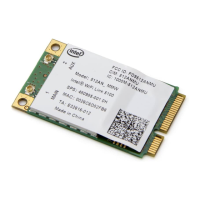Back to Contents
Enterprise Security
The Security Settings window is shown when creating or editing a profile. At the Security Settings page, you can
enter the required security settings for the selected WiFi network. See Personal Security
to set basic WEP or WPA
security in a non-enterprise environment (home, small business). See
Enterprise Security Settings to set up
802.1X security authentication options.
Use Enterprise Security if your network environment requires 802.1X authentication.
802.1X authentication methods include passwords, certificates and smart cards.
802.1X authentication types are: EAP-SIM, EAP-AKA, LEAP, TLS, TTLS, PEAP, EAP-FAST.
See Profile Management for a description of when the Profile Wizard is launched.
See Security Overview for more information about the different security options for wireless networks.
Enterprise Security Settings
Name Setting
Enterprise
Security
Select to open the Enterprise Security settings. The security settings that are available are
dependent on the Operating Mode selected: Device to Device (ad hoc)
or Network
(Infrastructure).
Network
Authentication
If you configure a profile for Device to Device (ad hoc) networking, the default setting is Open
authentication.
If you configure a profile for an infrastructure network, select:
Open: Any wireless station can request authentication.
Shared: Uses an encryption key known only to the receiver and sender of data.
WPA-Personal or WPA2-Personal: Uses a password also called a pre-shared key (PSK).
WPA-Enterprise or WPA2-Enterprise: Use on enterprise networks with an 802.1X RADIUS
server.
NOTE: WPA-Enterprise and WPA2-Enterprise are interoperable.
Data
Encryption
Click to open the following data encryption types:
None: No encryption.
WEP: WEP encryption provides two levels of security that use a 64-bit key (sometimes
referred to as 40-bit) or a 128-bit key (also known as 104-bit). If you use encryption, all
wireless devices on your wireless network must use the same encryption keys.
CKIP: Cisco Key Integrity Protocol is a Cisco proprietary security protocol for encryption
in 802.11 media. CKIP uses Key Permutation (KP) and Message Sequence Number to
improve 802.11 security in infrastructure mode.
TKIP: Provides per-packet key mixing, a message integrity check and a rekeying
mechanism.
AES-CCMP: (Advanced Encryption Standard - Counter CBC-MAC Protocol) Used as the
data encryption method whenever strong data protection is important.
Enable 802.1X
(Authentication
Type)
Click to open the following 802.1X authentication types:
TLS
TTLS
PEAP
LEAP
EAP-FAST
EAP-SIM: If in administrator mode, this only available for Pre-logon/Common profiles,
not Persistent.
EAP-AKA: If in administrator mode, this only available for Pre-logo/Common profiles, not
Intel® PROSet/Wireless WiFi Connection Utility User's Guide

